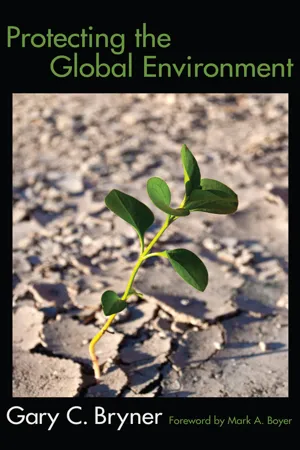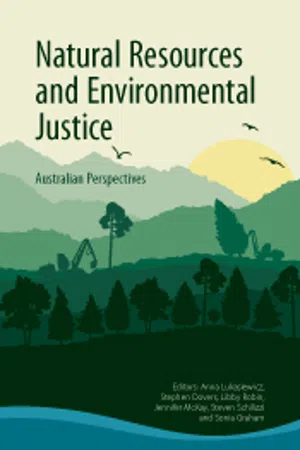Politics & International Relations
Environmental Justice
Environmental justice refers to the fair treatment and meaningful involvement of all people, regardless of race, color, national origin, or income, in the development, implementation, and enforcement of environmental laws, regulations, and policies. It aims to address the disproportionate burden of environmental hazards and pollution on marginalized communities and promote equitable access to a healthy environment.
Written by Perlego with AI-assistance
Related key terms
7 Key excerpts on "Environmental Justice"
- eBook - ePub
Environmental Justice and Land Use Conflict
The governance of mineral and gas resource development
- Amanda Kennedy(Author)
- 2017(Publication Date)
- Routledge(Publisher)
Efforts to define justice within the distributive paradigm have thus largely focused upon how to structure the allocation of substantive benefits and burdens within society; such a focus also occurs within the concept of Environmental Justice. Distributive Environmental Justice is concerned with the equitable sharing of environmental benefits and burdens across the population. A significant focus of much of the early Environmental Justice research was upon identifying patterns of uneven distribution among vulnerable groups, including Indigenous communities, communities of colour and the poor, who have been repeatedly found to be disproportionately impacted by environmental risks and harms (Schlosberg 2007; Figueroa 2003). Over time, however, the focus on proximity to harm has been broadened to other categories of disadvantage, most notably political inequality (Walker 2009, 2012). Environmental Justice is, therefore, no longer exclusively concerned with tracing the distribution of harm within impoverished and minority neighbourhoods; it can be ‘analysed within and between “communities” (however defined) where one community is more vulnerable to environmental deterioration than the other’ (Jessup 2013: 77). Accordingly, Environmental Justice scholarship has more recently turned its attention to spaces of political power and vulnerability within and between different scales (e.g - eBook - ePub
- Gary C Bryner(Author)
- 2015(Publication Date)
- Routledge(Publisher)
Devising solutions to environmental injustices is similarly fraught with challenges. The inequitable distribution of the burdens and benefits of environmental protection reaches well beyond the site selection and pollution focus of the traditional Environmental Justice movement to include the management of natural resource extraction. Actions taken to improve environmental quality may not result in improved social equity and may even exacerbate inequities. Policies that promote justice and strengthen the political power and decision-making influence of the poor and other marginalized groups may not produce improvements in overall environmental conditions. Allowing indigenous groups to continue to hunt and fish on traditional lands, for example, may be a justice imperative, but it may also threaten the survival of endangered species or clash with plans for protecting wilderness. Pursuing the goal of Environmental Justice requires innovative remedies that balance and reinforce the goals of strengthening the power of politically disadvantaged communities as well as improving environmental quality.A lively debate exists about the nature of the problem of Environmental Justice, the extent and seriousness of the risks, and the causes and underlying factors. But just as important and difficult is the question of what kinds of responses we should pursue. What are our options and how should we choose from among them? Natural resource laws and policies traditionally focus on encouraging development of resources, protecting natural systems, and ensuring the sustainability of resource development. These laws and policies are usually assessed in terms of how well they achieve these resource development and environmental protection goals and how they interact with economic goals of efficiency and growth. Environmental Justice advocates argue equal importance should be accorded to the consequences of natural resource policy decisions for the societal goals of protecting individual rights, promoting justice and fairness, ensuring fair participation, and fostering social equity.This chapter develops a framework for exploring alternative ways of defining injustices related to natural resources and the environment that are found in the relevant literature and public policies and also to suggest how Environmental Justice can be approached from different perspectives. The literature on EJ from U.S. scholars typically focuses on rights-based assertions of injustices in the distribution of environmental harms. More broadly, the EJ literature from the developing world centers on the lack of support for sustainable development for all humankind, particularly those in the poorest regions of the world. The chapter begins with a discussion of the alternative frameworks for defining EJ, which primarily come from the United States. It then takes up the question of EJ between nations. To broaden the analysis cross-nationally, it then turns to a brief case study on how the concept of Environmental Justice can help clarify some of the key issues surrounding climate change and the case of how the rights of indigenous peoples implicate environmental protection policy making. - eBook - ePub
Natural Resources and Environmental Justice
Australian Perspectives
- Sonia Graham, Anna Lukasiewicz, Stephen Dovers, Libby Robin, Jennifer McKay, Steven Schilizzi(Authors)
- 2017(Publication Date)
- CSIRO PUBLISHING(Publisher)
Reed and George 2011 ).Our ‘intersection point’ between justice and environment thus definitely includes the distributional and procedural aspects of Environmental Justice, but it also includes research in social justice, which looks at the allocation of goods and benefits within a society, focusing on distributive, procedural and relational fairness, often from the viewpoint of marginalised or disadvantaged stakeholders (Syme and Nancarrow 2001 ; Whiteman 2009 ). Social justice sometimes considers human–environmental interactions (Foster et al. 2010), but the majority of its research remains firmly anthropocentric. Both environmental and social justice often view the environment as a passive background against which justice is played out. Recently, a trend has emerged to pick an environmental theme and to concentrate justice research around it: for example, water justice (Perreault 2014 ; Zwarteveen and Boelens 2014 ); climate justice (Posner and Weisbach 2010 ); or food justice (Gottlieb and Joshi 2013 ; Wittman 2009 ). In contrast, ecological justice identifies the environment as a subject of justice – a stakeholder to whom justice is owed (Driscoll and Starik 2004 ; Opotow and Clayton 1994 ; Starik 1995 ; White 2008 ). Other fields that contribute to our ‘intersection point’ include: environmental law (Le Bouthillier et al. 2012); ecological economics (Costanza 1989 ); environmental philosophy (Mathews 2014 ); and aspects of political theory and research into human rights (Gearty 2010 ; Hancock 2003 - eBook - ePub
International Equity and Global Environmental Politics
Power and Principles in US Foreign Policy
- Paul G. Harris(Author)
- 2017(Publication Date)
- Routledge(Publisher)
I will argue in the following chapters that there is great practical significance in integrating equity into global environmental policy making. But here I have tried to suggest that there are strong ethical arguments, from a variety of philosophical perspectives, for promoting international environmental equity. While governments will continue to act primarily to promote their own national interests, ethical arguments can redirect their policies when their vital short-term interests are not threatened. Considerations of international equity can bolster these policies, and thinking about them can help scholars and laypersons understand the problems faced by negotiators at international environmental negotiations.Environmental issues, more than any others, are compelling governments and diplomats the world over—including those of the affluent countries—to seriously consider international equity. Questions of equity and justice in international relations were common in the 1970s—and subsequently declared moribund by most of the affluent countries in the 1980s. Yet, as the global environment becomes more polluted in the future, considerations of international equity will become increasingly germane to international relations. Environmental change and closely related requirements for sustainable development and poverty eradication in the developing world have already pushed equity back onto the global political agenda. This movement toward more serious consideration of equity in the context of global environmental politics, culminating in the Earth Summit and related international environmental deliberations, is the subject of the next two chapters.Notes
1 I first discussed these ideas in greater detail in Paul G. Harris, “Affluence, Poverty and Ecology: Obligation, International Relations and Sustainable Development,” Ethics and the Environment, 2, 2 (Fall 1997), pp. 121-38.2 For an elaboration of this definition, see Paul G. Harris, “Defining International Distributive Justice: Environmental Considerations,” International Relations - eBook - ePub
Shipbreaking in Developing Countries
A Requiem for Environmental Justice from the Perspective of Bangladesh
- Md Saiful Karim(Author)
- 2017(Publication Date)
- Routledge(Publisher)
North – South Dimension (Ashgate, 2004); Joni Adamson, Mei Evans and Rachel Stein, The Environmental Justice Reader: Politics, Poetics, & Pedagogy (University of Arizona Press, 2002); Laura Westra, Environmental Justice and the Rights of Indigenous Peoples: International and Domestic Legal Perspectives (Earthscan, 2012); Francis O. Adeola, ‘Cross-National Environmental Injustice and Human Rights Issues: A Review of Evidence in the Developing World’ (2000) 43 American Behavioral Scientist 686; David Naguib Pellow and Robert J. Brulle (eds), Power, Justice, and the Environment: A Critical Appraisal of the Environmental Justice Movement (MIT Press, 2005); Andrew Dobson (ed), Fairness and Futurity: Essays on Environmental Sustainability and Social Justice (Oxford University Press, 1999); Bunyan I. Bryant, Environmental Justice: Issues, Policies, and Solutions (Island Press, 1995); Luke W. Cole and Sheila R. Foster, From the Ground up: Environmental Racism and the Rise of the Environmental Justice Movement (New York University Press, 2001). 3 Brian Barry, ‘Sustainable and Intergenerational Justice’ in Andrew Dobson (ed), Fairness and Futurity: Essays on Environmental Sustainability and Social Justice (Oxford University Press, 1999) 94–117; Tomilola Akanle Eni-Ibukun, International Environmental Law and Distributive Justice (Routledge, 2014); Andrew Dobson, Justice and the Environment: Conceptions of Environmental Sustainability and Theories of Distributive Justice (Oxford University Press, 1998) - eBook - ePub
Environmental Justice
Key Issues
- Brendan Coolsaet(Author)
- 2020(Publication Date)
- Routledge(Publisher)
Speaking for Ourselves: Environmental Justice in Canada. Vancouver, BC: University of British Columbia Press.Pulido, Laura. 1996. Environmentalism and Economic Justice: Two Chicano Struggles in the Southwest. Tucson: University of Arizona Press.Schlosberg, David. 2007. Defining Environmental Justice: Theories, Movements, and Nature. Oxford: Oxford University Press.Taylor, Charles. 1989. Sources of the Self: The Making of the Modern Identity. Cambridge, MA: Harvard University Press.Taylor, Charles. 1994. The politics of recognition, in A. Gutmann (ed.) Multiculturalism: Examining the Politics of Recognition. Princeton: Princeton University Press.United Nations. 2007. United Nations Declaration on the Rights of Indigenous Peoples. Resolution adopted by the General Assembly on 13 September 2007.Whyte, Kyle. 2017. The recognition paradigm of environmental injustice, in Ryan Holifield, Jayajit Chakraborty and Gordon Walker (eds.) The Routledge Handbook of Environmental Justice. Abingdon: Routledge, pp. 113–123.Passage contains an image
6 Capabilities, well-being, and Environmental Justice 1
Breena HollandLearning outcomes
- Distinguish human capabilities as a conception of human well-being.
- Understand the direct and indirect ways that the natural environment supports capabilities.
- Identify threats to capabilities as different kinds of environmental injustice.
Introduction
Environmental Justice—whether conceived in terms of distributional equity, fair procedures, or recognition—2 - eBook - ePub
- Steve Vanderheiden(Author)
- 2017(Publication Date)
- Routledge(Publisher)
The practice of that logic has, however, sparked militant resistance. In the United States, the movement for Environmental Justice and against environmental racism has become a significant political force. It is a political movement that has been long in gestation, owing its most recent reincarnation to two particular incidents. First, the celebrated case of Love Canal in 1977, when houses built on top of an infilled-canal in Buffalo, New York, found their basements full of noxious liquids with serious health effects on resident children (Gibbs, 1982; Levine, 1982; Szasz, 1994). This led to the formation of a Citizen’s Clearing House for Hazardous Waste which, according to Taylor (1993) now works with over 7,000 community and grass roots groups nationwide. The second arose out of the 1982 protests in Warren County, North Carolina, when a mostly African-American community was selected as the site for burial of soil contaminated with PCBs. The vigor of the protests (multiple arrests of well-known civil rights figures) and the involvement of a wide range of organizations focused attention on what soon came to be known as “environmental racism.” In 1991, a very dispersed and highly localized movement came together around the First National People of Color Environmental Leadership Summit held in Washington, DC. There it adopted a manifesto defining Environmental Justice in no less than 17 different clauses (see Grossman, 1994). I select just a few:Environmental Justice :affirms the sacredness of Mother Earth, ecological unity and the interdependence of all species, and the right to be free from ecological destruction mandates the right to ethical, balanced and responsible uses of land and renewable resources in the interest of a sustainable planet for human and other living thingsdemands the cessation of the production of all toxins, hazardous wastes, and radioactive materials, and that all past and current producers be held stricdy accountable to the people for detoxification and the containment at the point of productionaffirms the need for urban and rural ecological policies to clean up and rebuild our cities and rural areas in balance with nature, honoring the cultural integrity of all our communities, and providing fair access for all to the full range of resourcesopposes the destructive operations of multi-national corporations … military occupation, repression and exploitation of lands, peoples and cultures, and other life formsrequires that we, as individuals, make personal and consumer choices to consume as little of Mother Earth’s resources and to produce as little waste as possible; and make the conscious decision to challenge and reprioritize our lifestyles to insure the health of the natural world for present and future generations.I shall return to these principles later, though it is not hard to see how many professionals might regard them as just as “insane” as Summers memo, while lacking the virtue of elementary let alone “impeccable” logic. The militant local struggles for Environmental Justice that coalesced to advance these theses created sufficient national political ferment, however, to force the EPA, even in its most recalcitrant Reagan—Bush years, to take up the issues of environmental equity. The EPA’s 1992 report on that issue conceded that there were problems of unequal exposure of minority and low-income populations to environmental risks, but asserts that there was not enough hard information to substantiate effective discrimination (except in the case of lead poisoning). In February 1994, however, the Clinton administration — responding to its constituencies of environmentalists, minorities, and the poor — issued an executive order to all federal agencies to ensure that programs would not unfairly inflict environmental harm on the poor and minorities. This means that the environmental needs of low-income and minority communities must be fairly addressed and that environmental issues can be adjudicated in terms of civil rights.
Learn about this page
Index pages curate the most relevant extracts from our library of academic textbooks. They’ve been created using an in-house natural language model (NLM), each adding context and meaning to key research topics.





